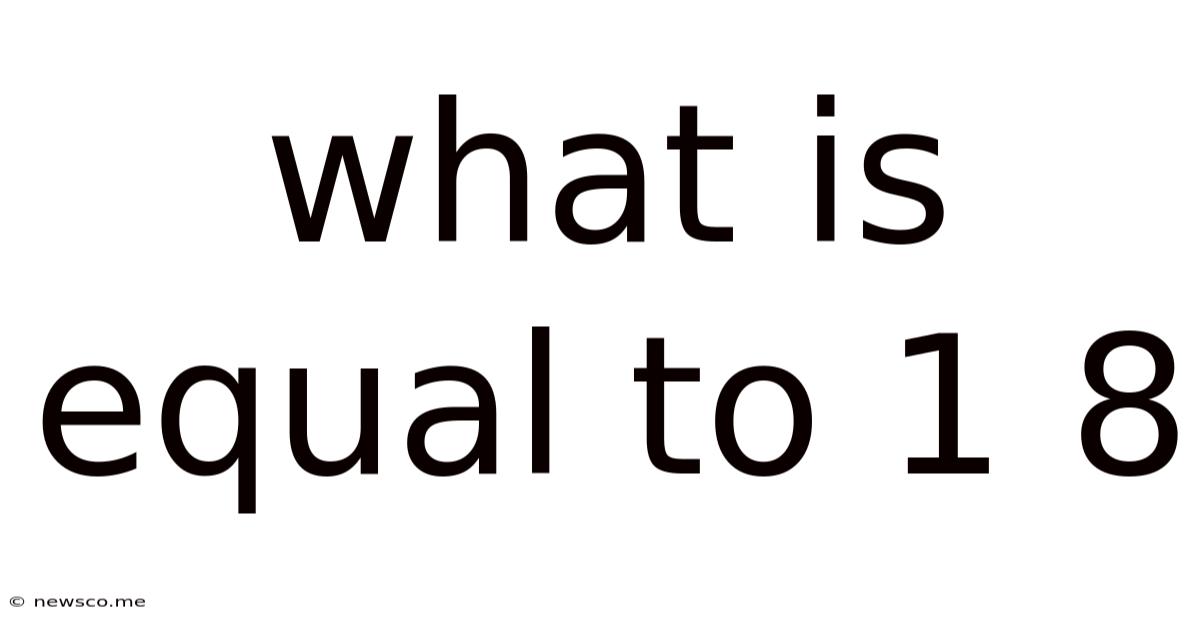What Is Equal To 1 8
News Co
Apr 18, 2025 · 5 min read

Table of Contents
What is Equal to 1/8? Exploring Fractions, Decimals, Percentages, and More
Understanding fractions is a fundamental aspect of mathematics, crucial for various applications in daily life and advanced studies. This comprehensive guide delves into the multifaceted meaning of 1/8, exploring its equivalent representations as a decimal, percentage, ratio, and its practical applications. We'll also examine how to add, subtract, multiply, and divide fractions involving 1/8, equipping you with a robust understanding of this seemingly simple fraction.
Understanding 1/8: The Basics
1/8, read as "one-eighth," represents one part out of eight equal parts of a whole. The number 1 is the numerator, indicating the number of parts we're considering. The number 8 is the denominator, representing the total number of equal parts the whole is divided into. Visualizing this can be helpful; imagine a pizza cut into eight equal slices. 1/8 represents one of those slices.
1/8 as a Decimal
To convert 1/8 into a decimal, we simply divide the numerator (1) by the denominator (8):
1 ÷ 8 = 0.125
Therefore, 1/8 is equal to 0.125. This decimal representation is often more convenient for calculations involving other decimals or percentages.
1/8 as a Percentage
Percentages express a fraction as a proportion of 100. To convert 0.125 (the decimal equivalent of 1/8) to a percentage, we multiply by 100:
0.125 x 100 = 12.5%
Thus, 1/8 is equal to 12.5%. This representation is useful for expressing proportions and comparisons, particularly in contexts like discounts, interest rates, or statistical data.
1/8 as a Ratio
A ratio compares two quantities. While 1/8 itself is a fraction, it can be expressed as a ratio:
1:8 (read as "one to eight")
This ratio indicates the relationship between one part and the total of eight equal parts. Ratios are commonly used in various fields like scaling, mixing ingredients, or comparing different quantities.
Equivalent Fractions of 1/8
While 1/8 is a simple fraction, it's part of a family of equivalent fractions. Equivalent fractions represent the same proportion but have different numerators and denominators. These are obtained by multiplying or dividing both the numerator and denominator by the same non-zero number. For example:
- Multiplying by 2: (1 x 2) / (8 x 2) = 2/16
- Multiplying by 3: (1 x 3) / (8 x 3) = 3/24
- Multiplying by 4: (1 x 4) / (8 x 4) = 4/32
All of these fractions – 2/16, 3/24, 4/32, etc. – are equivalent to 1/8. Understanding equivalent fractions is crucial for simplifying fractions and performing arithmetic operations.
Mathematical Operations with 1/8
Let's explore how to perform basic mathematical operations using 1/8:
Adding and Subtracting Fractions with 1/8
When adding or subtracting fractions, they must have a common denominator. If the fractions don't share a common denominator, you need to find the least common multiple (LCM) of the denominators and convert the fractions to equivalent fractions with that common denominator.
Example: 1/8 + 1/4
The LCM of 8 and 4 is 8. We convert 1/4 to an equivalent fraction with a denominator of 8:
1/4 = (1 x 2) / (4 x 2) = 2/8
Now we can add:
1/8 + 2/8 = 3/8
Example: 3/8 - 1/2
The LCM of 8 and 2 is 8. We convert 1/2 to an equivalent fraction with a denominator of 8:
1/2 = (1 x 4) / (2 x 4) = 4/8
Now we can subtract:
3/8 - 4/8 = -1/8
Multiplying Fractions with 1/8
Multiplying fractions is straightforward: multiply the numerators together and multiply the denominators together.
Example: 1/8 x 2/3 = (1 x 2) / (8 x 3) = 2/24 = 1/12 (simplified)
Dividing Fractions with 1/8
Dividing fractions involves inverting the second fraction (the divisor) and then multiplying.
Example: 1/8 ÷ 2/3 = 1/8 x 3/2 = 3/16
Practical Applications of 1/8
Understanding 1/8 has various practical applications in everyday life and different professions:
-
Cooking and Baking: Recipes often call for fractional measurements of ingredients. Knowing how to work with 1/8 ensures accurate measurements.
-
Construction and Engineering: Precise measurements are crucial in construction and engineering. 1/8 of an inch, for example, can be a significant difference in dimensions.
-
Finance and Accounting: Calculating percentages, interest rates, and proportions often involves working with fractions, including 1/8.
-
Data Analysis and Statistics: Representing data and proportions using fractions and decimals (including 0.125) is fundamental in data analysis.
Advanced Concepts Related to 1/8
The concept of 1/8 can be extended to more advanced mathematical topics:
-
Fractional Exponents: 1/8 can be expressed as 2⁻³ (2 raised to the power of -3). This connects fractions to exponential functions.
-
Calculus: Understanding fractions is essential for working with derivatives and integrals in calculus.
-
Complex Numbers: While not directly related, a solid understanding of fractions forms a base for tackling complex numbers and their operations.
Conclusion: Mastering the Power of 1/8
While 1/8 may seem like a simple fraction, its understanding underpins numerous mathematical concepts and practical applications. This guide has explored its various representations—decimal, percentage, and ratio—and demonstrated how to perform basic arithmetic operations involving this fraction. By mastering the fundamentals of fractions, including the nuances of 1/8, you build a strong foundation for more advanced mathematical studies and practical problem-solving across various fields. Remember that consistent practice and a conceptual understanding are key to confidently working with fractions of all types.
Latest Posts
Related Post
Thank you for visiting our website which covers about What Is Equal To 1 8 . We hope the information provided has been useful to you. Feel free to contact us if you have any questions or need further assistance. See you next time and don't miss to bookmark.